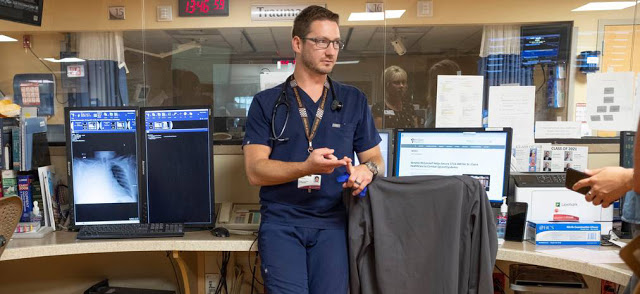Kentucky doctors and hospitals are changing the culture of opioid prescribing, acknowledging their role in spurring the epidemic

Dr. Philip Overall in the emergency room at St. Claire Hospital in Morehead, which has cut the unit’s opioid-prescription rates by half. (Photo by John Flavell for the Lexington Herald-Leader)
—–
Acknowledging their role in causing the opioid epidemic, some Kentucky doctors have mounted an effort with hospitals to reduce prescriptions of painkillers.
The effort began at St. Claire Hospital in Morehead, which has stopped using opioids as its first response to pain. It has been adopted by the University of Kentucky and endorsed by the state health cabinet and the Kentucky Hospital Association.
This is “the first coordinated push . . . to stifle traditional opioid prescribing practices” in Kentucky, reports Alex Acquisto of the Lexington Herald-Leader. “Progress has mostly been a result of independent gumption on the part of providers,” like Dr. Philip Overall, emergency-room director at St. Claire, and Dr. Phillip Chang, chief medical officer for UK HealthCare.
 |
| Dr. Phillip Chang (H-L photo by Alex Slitz) |
Chang came up with the Kentucky Statewide Opioid Stewardship program, or Kentucky SOS. He and other doctors, mostly from Central Kentucky, have formalized its philosophy “into an actionable plan for others,” which has been accepted by “all but nine of the state’s 125 hospitals,” including all acute-care and critical-access hospitals, Acquisto reports. “For its statewide scale and applicability across hospital departments, KY SOS is the first of its kind in the country, Chang said.”
The hospitals are collecting prescription data for Chang and his team, who will use it to develop appropriate reduction benchmarks hospitals should aim for, Acquisto reports.
The doctors’ idea came from experiences with patients.
Dr. Jacob Perry, a St. Claire surgeon, “performed an emergency laparoscopic surgery to remove a patient’s gallbladder — an invasive procedure that pretty much guaranteed an opioid prescription to deal with post-operation pain,” Acquisto writes. “Instead of taking the painkillers his patient had been given, she managed her pain with Advil, and two days later, she returned to work. Perry recalled being flummoxed, and then determined: If all she needed was an over-the-counter pain pill, could others manage their pain the same way?”
Perry started asking patients to whom he had prescribed opioid how many pills they had taken, and “The vast majority were like, 1, 2, 3, maybe four,” he said. SO, “He began lowering some of his prescription doses, from 30 to 20,” Acquisto reports.
Perry was mentored by Chang when he was at UK. Chang’s inspiration came in 2013, when he was UK’s chief of trauma and critical care, Acquisto writes: “A male patient in his 20s kept visiting Chang’s clinic for a few weeks after being treated for a trauma injury. Each time he visited he complained of pain, and each time Chang refilled his opioid prescription.”
“People ask why we’re not after meth or cocaine,” Chang said. “Because three out of four heroin users started with prescription opioids, meaning something we wrote. This is the only addiction crisis that started with hospitals and physicians. This is the only thing we caused. This we’re responsible for.”
The Morehead hospital urges its staff are urged to maximize alternatives to opioids, “like ice, heat, and over-the-counter painkillers such as acetaminophen,” Acquisto reports. “Ibuprofen, muscle relaxers, and other non-steroidal anti-inflammatory drugs (NSAIDs). If opioids are necessary, “prescribe the lowest effective dose and quantity,” or a dose that lasts no longer than three days, the hospital says.